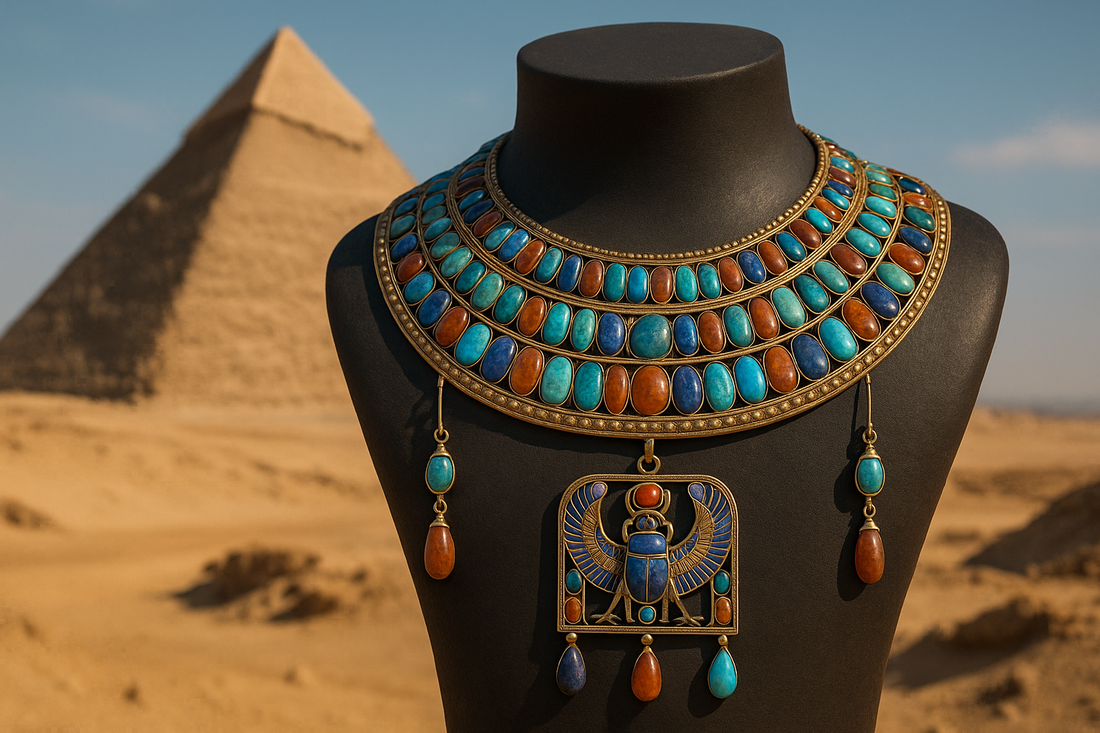
Gemstone Trade in Ancient Egypt
Cody ManesShare
TL;DR
Ancient Egypt was a major hub of gemstone mining, symbolism, and international trade. Stones like turquoise, carnelian, amethyst, and lapis lazuli held cultural, religious, and economic importance. Local mines supplied much of Egypt’s needs, while long-distance trade brought exotic stones from as far as Afghanistan. These practices shaped jewelry, ritual objects, and burial customs, leaving a legacy that influenced civilizations across the Mediterranean and Near East.
Key Facts
| Aspect | Details |
|---|---|
| Major Local Gems | Turquoise, Carnelian, Amethyst |
| Imported Gems | Lapis lazuli (from Afghanistan), obsidian, garnet |
| Mining Sites | Sinai Peninsula (turquoise), Eastern Desert (amethyst, carnelian) |
| Symbolism | Turquoise (rebirth, joy), Lapis lazuli (divinity, wisdom), Carnelian (vitality, protection) |
| Trade Routes | Connected to Mesopotamia, Levant, Nubia, and Central Asia |
Q&A
Q: Where did Egyptians mine gemstones?
A: Egyptians relied heavily on local sources for many of their gemstones, and mining was a carefully organized activity often overseen by the state. The turquoise mines of the Sinai Peninsula were among the most famous, particularly at Serabit el-Khadim, where inscriptions dedicated to the goddess Hathor mark the sacredness of the resource. In the Eastern Desert, amethyst was quarried at Wadi el-Hudi, sometimes with expeditions involving hundreds of workers. Carnelian could be collected from dry riverbeds and gravel deposits, while malachite was mined near the Nile Valley and used both as a pigment and as jewelry material. These mining ventures were dangerous, requiring long journeys into remote deserts, but they were essential to Egypt’s wealth and spiritual culture.
Q: Which gemstones were imported into Egypt?
A: Although Egypt had abundant local resources, it lacked certain prized stones, the most famous being lapis lazuli. This deep blue stone came exclusively from the Badakhshan region in modern Afghanistan, reaching Egypt through complex trade routes passing through Mesopotamia and the Levant. The rarity of lapis and the effort required to transport it made it one of the most valued stones in Egyptian art and ritual. Other imported materials included obsidian, which was prized for blades and ritual objects, and garnet, which was used in jewelry. These imports show that Egypt was part of an interconnected trade system stretching thousands of miles, with gemstone trade reinforcing its role as a cultural and economic powerhouse in the ancient world.
Q: How were gemstones used in Egyptian religion?
A: Gemstones were not merely decorative; they were deeply integrated into Egypt’s religious and spiritual practices. Stones were shaped into amulets representing protective deities, scarabs symbolizing rebirth, and ritual inlays used in temple offerings. Lapis lazuli was particularly sacred, often associated with the night sky and divine wisdom, making it a natural choice for priestly regalia and ritual figurines. Green stones such as jasper symbolized regeneration and eternal life, explaining their frequent use in funerary artifacts like Heart Scarabs. The belief that gemstones could carry spiritual power meant they were used to bridge the human and divine worlds, ensuring protection both in life and in the journey after death.
Q: What role did gemstone trade play in Egypt’s economy?
A: Gemstone trade was vital not only for wealth but also for diplomacy and cultural exchange. Egypt exported turquoise, carnelian, and worked jewelry to neighboring regions such as Nubia, the Levant, and Mesopotamia. These exports enhanced Egypt’s reputation as a land of abundance and artistic mastery. Imports of lapis and other exotic stones also fostered long-distance trade relationships that tied Egypt into the broader networks of the ancient Near East. For Egypt’s rulers, controlling gemstone sources and trade routes was a way of displaying power, since access to these materials symbolized divine favor and royal authority. The steady flow of gems into temples and treasuries reflects their importance as both economic and symbolic capital.
Q: How did Egypt influence later gemstone use?
A: The gemstone traditions of Egypt had a profound impact on later cultures. Greek artisans borrowed Egyptian scarab designs, adapting them into new jewelry fashions. Roman jewelers refined techniques of engraving and inlay that were first perfected in Egypt. Beyond craftsmanship, the symbolic meanings attached to certain stones, such as lapis representing divinity or carnelian symbolizing protection, spread into Mediterranean and Middle Eastern traditions. These ideas influenced not only jewelry but also mystical and medical practices, as stones were believed to carry healing or protective powers. Egyptian lapidary knowledge also informed medieval European bestiaries and Renaissance texts on mineralogy, keeping ancient concepts alive in scholarly and magical contexts. In this way, the gemstone culture of Egypt continued to shape human beliefs, artistic traditions, and medical theories long after the decline of the pharaohs.
Deep Dive
Mining and Local Resources
Mining expeditions for gemstones were documented as early as the Old Kingdom. The turquoise mines at Serabit el-Khadim in Sinai were inscribed with hieroglyphs dedicated to Hathor, the goddess of joy and fertility. Amethyst mining peaked in the Middle Kingdom, with quarries in Wadi el-Hudi providing rich deposits. Carnelian, gathered from desert riverbeds, was commonly used for beads and inlays. Archaeologists have found remnants of miners’ huts, broken tools, and unfinished beads at these sites, showing that production often happened directly at the quarries. Ancient inscriptions sometimes recorded the number of workers sent and the duration of expeditions, offering rare insights into labor organization. The reliance on both seasonal flooding of the Nile for transport and pack animals across desert routes highlights how gemstone mining was intertwined with Egypt’s broader system of agriculture, trade, and state planning.
These mining operations were state-controlled, reflecting the political and spiritual value of gemstones. Workers faced dangerous conditions, but the rewards enriched both temple offerings and royal treasuries. Expeditions often included scribes to record yields, soldiers to provide protection, and priests to sanctify the work, underscoring how mining was tied to both administration and ritual. Archaeological evidence shows that camps built near quarry sites had storage facilities, workshops, and shrines, revealing the organized nature of gemstone extraction. The logistics of transporting heavy loads of turquoise, amethyst, or carnelian across deserts also demonstrate Egypt’s mastery of resource management and the importance of gemstones in sustaining its cultural and economic power.
Symbolism and Spiritual Meaning
Each gemstone carried specific symbolic meanings. Turquoise symbolized joy and protection, often associated with Hathor. Lapis lazuli, with its deep celestial blue, was linked to the heavens and divine authority, favored for scarabs and royal regalia. Carnelian was tied to vitality and courage, making it a popular choice for protective amulets. Amethyst was associated with clarity and healing. Green stones such as jasper and feldspar were thought to represent rebirth and regeneration, aligning with the seasonal cycle of the Nile. Quartz crystals were also occasionally used and may have been valued for their light-reflecting qualities, connecting them to purity and spiritual illumination. These symbolic associations reveal how Egyptians linked natural colors and mineral qualities with cosmic order, divine protection, and the promise of eternal life.
Gemstones were frequently included in tombs to safeguard the deceased. Tutankhamun’s burial mask famously features inlays of lapis lazuli, turquoise, and carnelian, reinforcing the connection between gemstones and eternal life. Other royal burials contained elaborate pectorals and rings set with amethyst, jasper, and green feldspar, each stone selected for its symbolic ability to protect the spirit in the afterlife. Inscriptions on funerary jewelry sometimes invoked deities or magical spells, showing how gems were more than decoration, they were part of a sacred toolkit for navigating the dangers of the Duat, the Egyptian underworld. The inclusion of gemstones in these contexts demonstrates how material beauty was intertwined with theology, magic, and the eternal hope for rebirth.
Trade and International Networks
Egypt’s gemstone trade extended far beyond its borders. Lapis lazuli traveled along complex routes from Afghanistan through Mesopotamia and into the Nile Valley. Egypt, in turn, exported turquoise, carnelian, and crafted jewelry to Nubia, the Levant, and even further afield. Archaeological discoveries show Egyptian beads and inlays reaching as far as Mycenaean Greece and early Mediterranean ports, suggesting that luxury items circulated widely. These interactions were not limited to commerce but also carried diplomatic weight, as rulers exchanged gem-encrusted gifts to secure alliances. The movement of gemstones across such long distances illustrates how Egypt was a central hub in Bronze Age trade networks, linking Africa, Asia, and Europe through shared demand for rare and symbolic minerals.
These exchanges reinforced Egypt’s economic power and cultural influence. Egyptian jewelry has been discovered in foreign burials, indicating demand for both raw stones and finished luxury items. Finds of faience beads, carnelian pendants, and gold-inlaid amulets in tombs outside the Nile Valley suggest that Egyptian craftsmanship was valued as much as the materials themselves. Some foreign elites even imitated Egyptian styles, showing how gemstone trade carried aesthetic and symbolic ideas across borders. Such evidence highlights that Egypt was not only an exporter of minerals but also of cultural identity expressed through its gem-encrusted art and ritual objects.
Religious and Funerary Practices
Gemstones were central to funerary rites. Heart Scarabs, often made of green jasper or carnelian, symbolized the weighing of the heart in the afterlife. Amulets shaped like the Eye of Horus were crafted from turquoise or lapis to protect the deceased. Additional amulets such as the Djed pillar, often carved from green feldspar, represented stability and continuity, while the Ankh amulet symbolized eternal life. Some burial assemblages included dozens of small gem amulets sewn into the wrappings of the mummy, creating a protective shield of mineral power. The choice of stones reflected not only aesthetic preference but also a theological system where color, mineral properties, and symbolic form combined to safeguard the soul on its journey through the Duat.
Priests used gemstone-inlaid ritual tools in ceremonies. Lapis lazuli’s celestial symbolism made it especially important for connecting rituals to divine forces. Ritual staffs, pectorals, and offering bowls were often decorated with turquoise, carnelian, and green jasper to align their colors with cosmic principles. Some temple inscriptions describe these stones as channels for divine energy, ensuring that prayers and offerings reached the gods effectively. The integration of minerals into sacred instruments shows how Egyptian religion viewed the natural world as an active participant in ritual practice, with gemstones acting as both material and spiritual conduits.
Influence on Later Cultures
The gemstone traditions of Egypt inspired Mediterranean cultures. Greek artisans adopted Egyptian scarab designs, while Roman jewelers inherited lapidary techniques from Egypt. Egyptian motifs appeared on rings, seals, and pendants throughout the Hellenistic world, showing the enduring appeal of pharaonic symbolism. The symbolic meanings of stones carried into later mystical and medical traditions in Europe and the Middle East, where lapis was associated with wisdom and protection, and carnelian was linked to vitality and courage. Medieval alchemists and physicians cited Egyptian practices in their mineral treatises, keeping these traditions alive and blending them with new interpretations that spread across continents.
